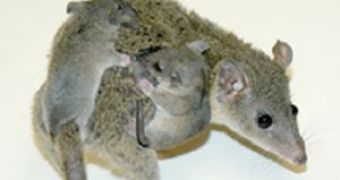In order to understand the evolution of mammals geneticists have to compare the genetic code of various mammals with that of fish and birds. But the genetic codes of most mammals are too similar among each other while being too different from those of fishes and birds. However, marsupial mammals and monotremes (egg-laying mammals) are primitive mammals that allow such comparisons. They are sufficiently different from mammals like us but in the same time sufficiently similar to fishes and birds. (The only monotremes existing today are the platypus and echidna.)
An international team led by Kathy Belov from the University of Sydney's Faculty of Veterinary Science has documented the genetic code of marsupials for the first time. They focused on the evolution of the immune system and used genome sequences of the gray, short-tailed opossum (Monodelphis domestica), a marsupial found in South America.
"Interest in marsupial and monotreme genomes comes from their important positions in vertebrate evolution," says Belov. "Comparing genes of placental mammals, such as the human and the mouse, is not very efficient because their genes can be so similar it is hard to pinpoint regions that remain unchanged because they serve a particular purpose. In contrast, comparison of distantly related genes, such as the chicken and human, can be difficult, because the sequences are so different."
"Marsupial and monotreme genomes fill this gap. They are easily aligned with placental mammal genomes, yet are different enough to pinpoint regions that have important functions and therefore have been conserved for long periods of time. The monotremes split off from other mammals 210 million years ago. The remaining marsupials split from the main (placental) group about 180 years ago."
Belov and her team found that while the size and complexity of an important cluster of immune genes (called MHC) in the opossum is closer to eutherian (placental) mammals, its organization is closer to fish and birds. In higher mammals, MHC is responsible for the production of certain proteins used by the organism to differentiate its own cells from invader cells. Each cell wears these proteins like a sort of tag saying "I'm ok, I work here" and protects them from being destroyed by the immune system.
Beloy explains: "The clues we unearthed by looking at different genomes are also helping us to understand how our own intricate immune system evolved from the relatively simple immune system seen in lower vertebrates such as birds and fish. Mapping the opossum MHC has allowed us to deduce what the MHC of ancestral mammals looked like. We think it contained several different types of immune genes in a single complex. These genes are no longer found in a single complex in any living animal but are scattered over various chromosomes. We have named this complex 'The Immune Supercomplex.'"
The "immune supercomplex" no longer exists in modern genomes. Another significant find is that, at first, the MHC has been related to another critical component of the immune system, called the natural killer complex (NKC). Apparently MHC and NKC separated at a certain point in evolution. The paper is the result of international collaboration between Australian National University (ANU), The Walter and Eliza Hall Institute of Medical Research, the University of New Mexico, Texas A&M, the Southwest Foundation for Biomedical Research and the University of Pittsburg and is published in the highly regarded open-access journal PLoS Biology.
Photo credit: Belov et al.

 14 DAY TRIAL //
14 DAY TRIAL //